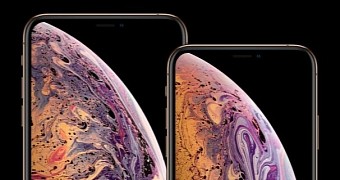As if Apple’s problems with the iPhone weren’t enough, two customers are now suing the company for allegedly hiding the notch in the official photos of the iPhone XS and iPhone XS Max.
In lawsuit papers, they explain that Cupertino is thus hiding the fact that the 2018 iPhones have fewer pixels that it seems, basically because the notch reduces the available screen estate.
“Defendant’s website is designed to encourage comparisons between the Products and Defendant’s other phones. These comparisons are misleading because the Products have false screen pixel counts that dramatically overrepresent the number of subpixels in the phones,” the lawsuit reads.
While the lawsuit is still pending class-action status, Apple’s alleged sneaky tactics to hide the notch basically comes down to using a black wallpaper that makes the upper part of the screen barely noticeable.
The notch is one controversial design choice that many criticized after being introduced on the iPhone X. Several Apple rivals mocked the company for launching a phone with a notch, including Samsung, but this eventually became a trend, with other device manufacturers embracing it, like Huawei.
On the other hand, the notch is considered to be one of the reasons sales of new iPhones fail to meet expectations, as more customers want to stick with the traditional design.
Apple tight-lipped on its notch approach
The lawsuit also reminds of the iPhone 8 Plus, which has a bigger screen estate that iPhone XS, as explained in the court documents.
“The iPhone X Product is advertised as having 2436×1125 pixels, but in fact does not use true pixels with red, green, and blue subpixels in each pixel. Instead, the Product has only false screen pixels, with just two subpixels per false pixel (2436×1125×2 = 5,481,000 subpixels), and it does not actually have any subpixels at all in the notch at the top of the screen or in the display-area corners.
In contrast, the iPhone 8 Plus has a higher quality screen than the Product, with more subpixels than the Product (1920×1080 pixels×3 subpixels per pixel = 6,220,800 subpixels).”
In pure Apple fashion, the company hasn’t responded to the lawsuit and it’s unlikely we’ll ever hear from it on this particular controversy. The full legal complaint is available here.

 14 DAY TRIAL //
14 DAY TRIAL //